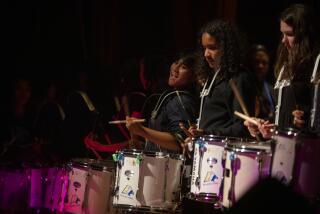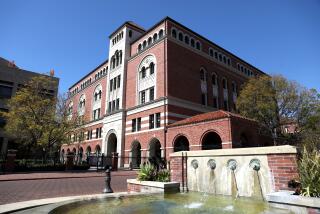Exclusive: The dean of the USC art school with only one MFA student responds to her critics
Can a major university art school program continue if it has only one student?
Ever since the entire 2016 class of seven studio arts MFA students withdrew from USC’s Roski School of Art and Design in May over changes to faculty, curriculum and funding, many have wondered about the future of the school’s master of fine arts program and weighed in on the future of arts education in general.
In an exclusive interview with The Times, Erica Muhl, dean of the Roski School, reveals that for the fall semester set to begin in less than two months, only one incoming student is enrolled in the studio art MFA program’s class of 2017.
“We have one,” she says. “That’s it.”
Muhl, however, is undaunted. She says the university is committed to maintaining the program that has long produced internationally known artists, including Paul McCarthy, Amanda Ross-Ho and Elad Lassry.
Until now, Muhl, who joined Roski as interim dean in 2012 and became dean in 2013, has issued only a couple of public statements on the matter using the university’s website. More than 70 alumni of the program made their own public statement, in an open letter critical of “reckless changes” to the program, involving core faculty, artist studio visits and guaranteed teaching assistant positions for the MFA students.
During a brief telephone conversation (which has been edited for flow), Muhl discusses the changes to the MFA program and her vision going forward.
The Roski MFA program has been known as a strong studio-based program. Why were changes made?
That’s a very broad question. I’ll answer it a little broadly at first. I consulted very closely with faculty over the course of nearly two years, and we decided together to make a few salient changes to the program — changes that will not affect the class of 2016, the students who just withdrew. These changes would not have affected their curriculum. There were those who were very comfortable with the program the way that it was. But this was the right decision for the university.
Our MFA has always and will continue to provide a studio-based experience. But we want students to benefit not just from what Roski can offer but what all of USC can offer: all of our faculty in the art and humanities and social sciences, the entire university-wide network. We had to open avenues for the students to interact with other students and faculty at USC. This would happen by creating electives -- and by greater interactions with our other MA students, such as curatorial practices.
You’ve said these changes wouldn’t have affected the class of 2016, yet the students say part of the reason they withdrew is because they faced new requirements that were not part of the original curriculum: a pedagogical, or teaching-related, course and a new course called Global Art.
The pedagogy course was not required for the class of 2016. And the Global Art component was brought about inside a theory course that was already required. That was initiated in the summer of 2014 by the previous MFA director. Plus, we provided an international trip for the MFA, fully funded, to Mexico City. We thought it resonated with students. We thought it was an opportunity for them to work with other faculty and students at USC.
The students allege that the trip — which had been guaranteed to them in their offer letters — was going to be canceled.
They did bring that up with me. We did discuss that the international trips require a great deal of planning and budgetary considerations. They pointed out that they wanted something in their curriculum in the fall of 2015. We worked to provide that for them. That would have been part of their curriculum. I believe the trips that were planned with those faculty were to the California-Mexico border region, and there would have been local trips in and around the Los Angeles area to studios, galleries and museums.
Are the changes part of a new direction for the Roski School of Art and Design?
Regarding the MFA itself, we consider the changes we’ve made to be pretty minor especially in the context of a two-year course of study. Some don’t feel that is so. But I feel that we’re crafting it in a way that is unique to USC and distinguishes it from its peers.
That’s part of the over-arching vision for Roski. The MFA program is a very fine arts program within a major research university. But it has not taken advantage of all the resources and funding, all the other areas of the university. My vision is to broaden Roski’s reach so that students have the benefit of interacting with those other areas more effectively but, more importantly, so that the university has the benefit of interacting with our students.
Why do you think you only have one student for the fall?
The negative publicity may have affected recruitment efforts. But we have an incredibly strong program, and we will continue to support it. We are going to support an International Artist Fellow [a fully funded position], who will attend in the fall. We are looking to pause recruitment and then continue to recruit at a later date.
Is that a nice way of fading out the studio arts program?
I am deeply committed, deeply committed to the MFA. We will begin recruiting this fall, so we are hoping to have a very robust class. [For the incoming MA in curatorial studies,] there are eight students enrolled. That’s a robust class for that program.
All of the salient aspects of the [studio arts] program remain in the program. That includes the ability to access, on a regular basis, not just core faculty but also high-profile visiting artists. We’ve increased that ability going forward. We’ve added a deeper dive with our visiting artists in the graduate lecture series by adding a seminar-type session. We’ve added a new program, a resident artists and scholars program, which will bring artists in residence.
We’ve had good feedback on this, the ability to hear and see and talk with artists, but also curators, critics and scholars — some of whom do studio visits. That is part of the program we intend to continue. The other element is that we’re one of the few programs in the country that has built a vibrant critical studies curriculum at the graduate level.
How will the faculty work with this one MFA student? Will there be dedicated core faculty attached to the program? Or will the student be added to other departments?
Core faculty in the MFA program always taught undergraduate as well, so that is still the same. We still have a dedicated core of faculty in the MFA. I have not altered that. Core faculty were always responsible for studio visits. They’re also an important part of envisioning the team, and they craft the entire experience for every MFA student. Also, we have a very strong group of adjunct faculty for the MFA as well. The goal is a strong collaboration so that the MFA experience is quite unified.
This will be one fantastic experience for the International Art Fellow. I’ve spoken with her. She’s really looking forward to interacting with the master’s students as part of her cohort.
In addition to your role as Roski dean, you are also director of the Jimmy Iovine and Andre Young Academy, a program that has a creative component but is also entrepreneurially minded with technology and business elements. How does this fit with what Roski’s art department does?
It doesn’t fit into the Roski School. It’s a separate entity. It’s one that we’re very proud of and we feel is very important. But the philosophy behind Iovine and Young has nothing to do with the philosophy behind the Roski School. I’m a classically trained artist. I deeply believe in traditions and depth and what we have created here at Roski. And I am committed to maintain that core.
The intersection of Roski and Iovine and Young is very informal, but it’s very positive for both programs. The Roski School has benefited in the way of guests and events. More important is the fact that there is interchange and exchange and interaction with Iovine and Young students. It certainly benefits the Iovine and Young students. That’s an undergraduate program.
The MFA program has been under the guidance of an interim director. Will the program have its own director?
We just made a significant hire. But I can’t announce it yet. We’ll announce that in the fall.
All of this comes at a time when some have been critical of the corporatization of academia — of programs that are industry-friendly and get away from traditional courses of liberal arts study that are more about critical thinking. What’s your reaction to that?
As a dean, I’ve never been given any instruction and I’ve never seen any real philosophy like that at play at USC. Our goal is to create excellence in everything that we do. Always as a dean, I always have my eye on the feasibility of everything that we do and being able to fund unique and special programs. But that is not something that I have experienced personally.
Last week, six dozen alumni wrote you an open letter about their displeasure with the goings-on at Roski. What would you say to them given the opportunity?
The alumni care very deeply about this school. They did not contact me before writing that letter. But I hope to speak to them at a future date. There are students on that list with whom I’ve had important interactions in the past, some of whose work I know very well. And I welcome the opportunity to talk with them.
Find me on Twitter @cmonstah.
More to Read
The biggest entertainment stories
Get our big stories about Hollywood, film, television, music, arts, culture and more right in your inbox as soon as they publish.
You may occasionally receive promotional content from the Los Angeles Times.







